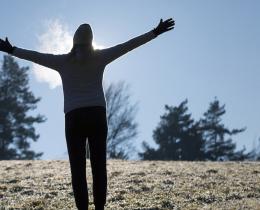What: Standing meditation encourages you to tune into your body—and the present moment—while standing up or holding a specific standing yoga or tai chi pose. Some teachers may invite you to focus on the physical sensations of standing while tuning into the world around you. Others may encourage you to focus on your breathing and/or an internal visualization.
Types: Jon Kabat-Zinn’s standing meditation (see below). Standing meditation can also be practiced in the context of meditative martial arts, such as tai chi, and during yoga practice in postures like tree pose or mountain pose.
Benefits: Although no studies have been conducted specifically on standing meditation, we can reasonably assume it comes with many of the same benefits as the traditional breathing meditation practice. It also helps release tension and strengthen core muscles.
Keywords: still, statuesque, enlivening
Try this: In Wherever You Go, There You Are, mindfulness meditation trailblazer Jon Kabat-Zinn suggests standing in a forest or near a single tree to begin your practice. Imagine your feet are sending roots into the earth. Use your breathing to bring you into the present moment. If you’d like, close your eyes and tune into your surroundings, letting your body sway slightly, just as a tree would. Jon suggests focusing on the sensations of your body “standing, breathing, being, moment by moment.”
When you first get the impulse to stop the meditation, stay a few minutes longer, remembering that many trees stand tall for decades. “Work at being in touch with the air on your skin, the feel of your feet in contact with the ground, the sounds of the world…[and] the dance of the mind,” he writes.



